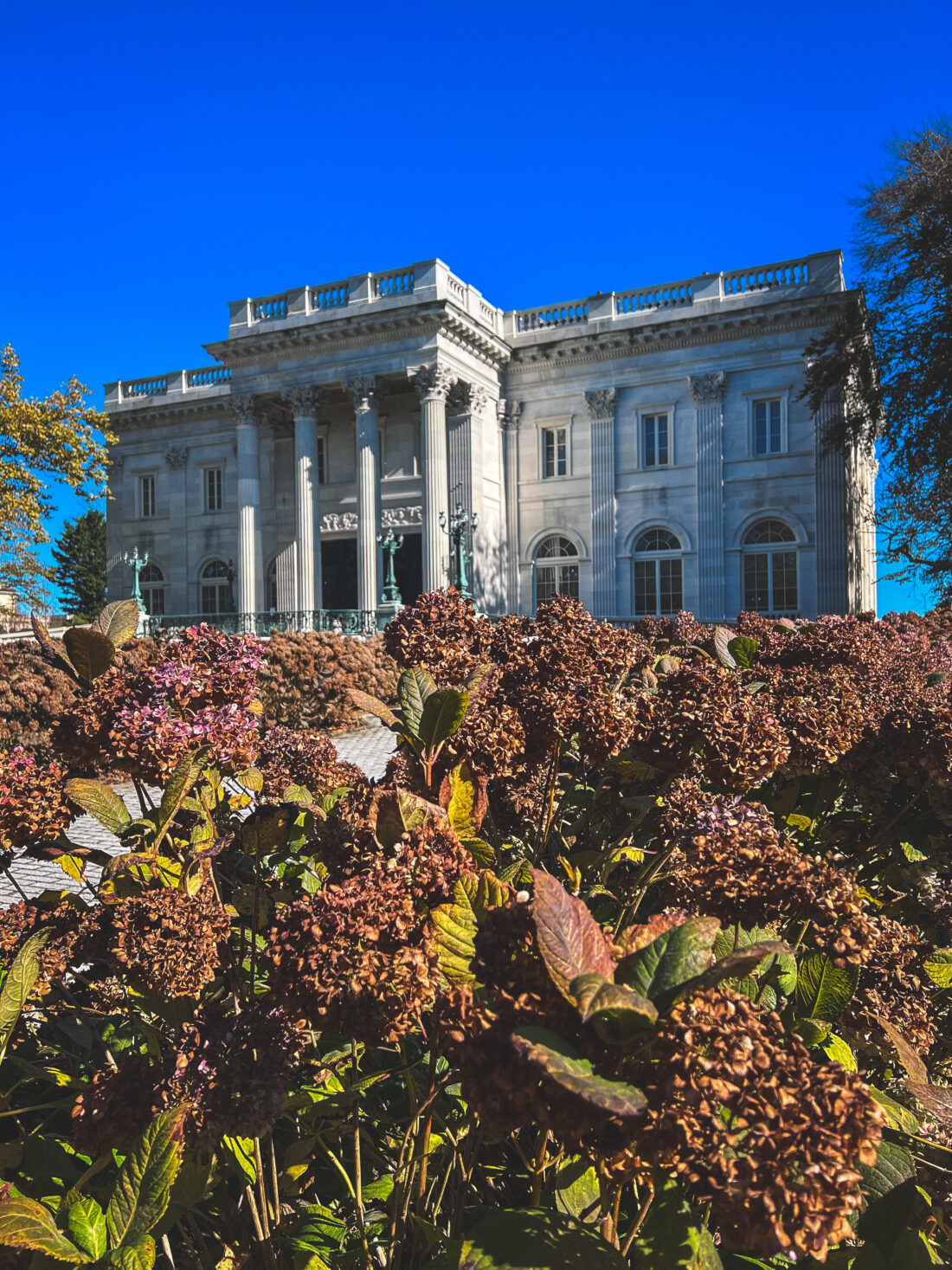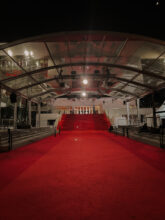Have you ever just sat down and thought to yourself – man, I wish my home was made of marble? Well, if you have, you’re in the company of the Vanderbilts. Meet the Marble House.
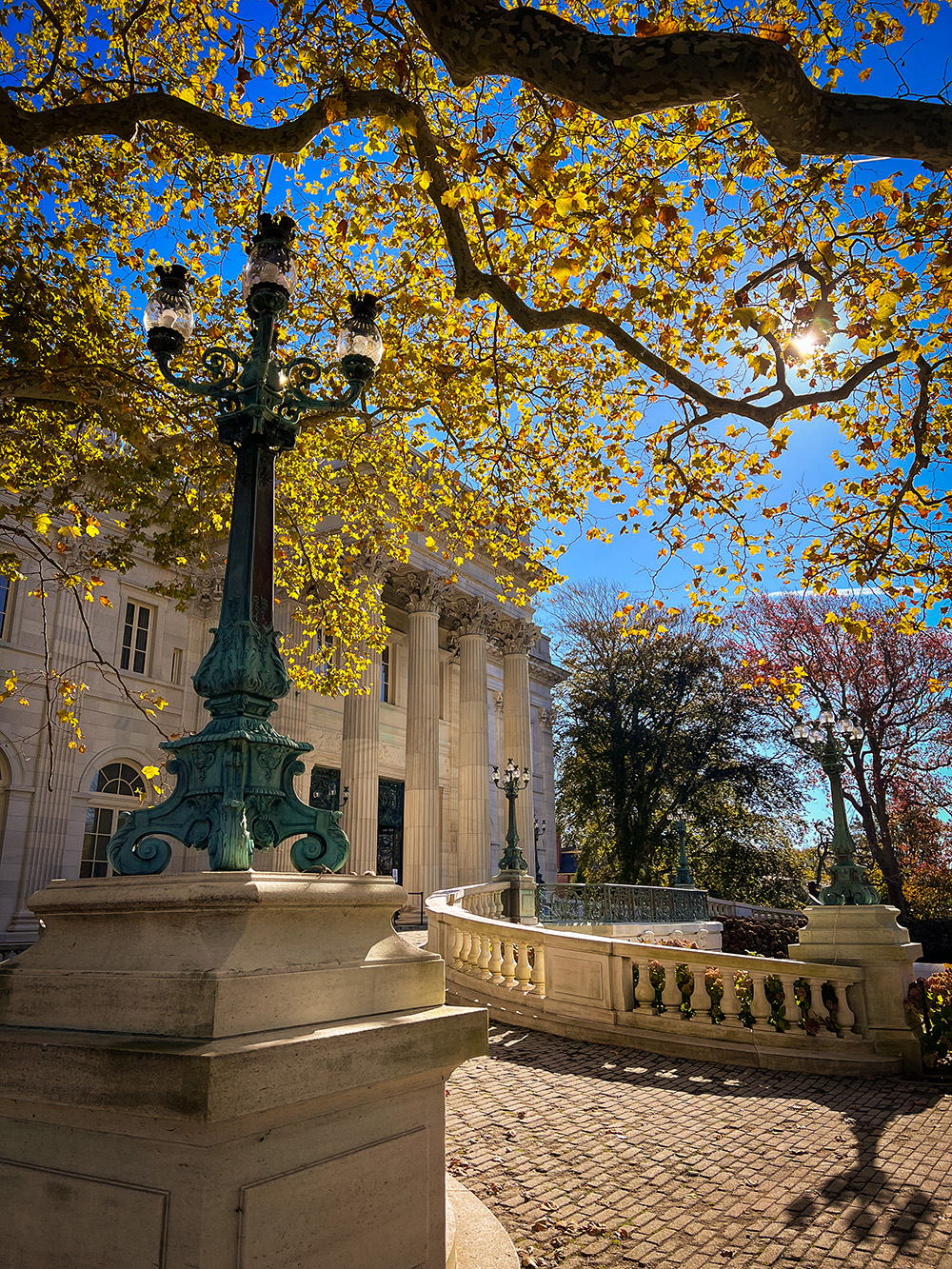
This mansion was a gift to Alva Vanderbilt for her 39th birthday, and was modeled after the Petit Trianon, which happens to be where I stayed while in Versailles.
In fact, the back of the home looks exactly like the hotel I stayed at.
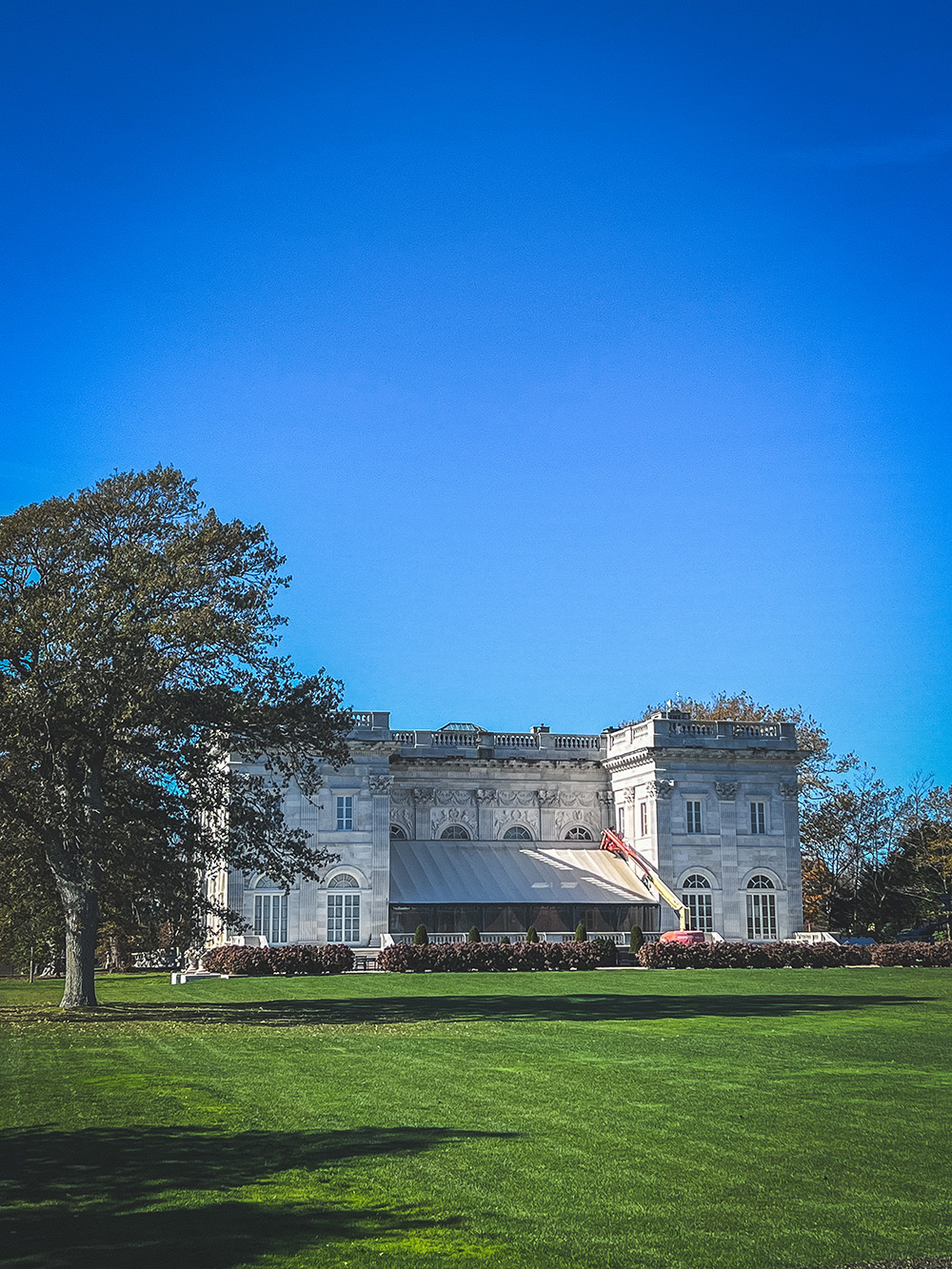
It was truly uncanny. The section with the canopy is exactly where I would have eaten breakfast in Versailles.
You’ll understand why the Marble House has it’s name in just a moment, but for now, a fun fact: the mansion holds 500,000 cubic feet of marble.

In comparison to The Breakers, The Marble House had this little sign about disruptive children, which I thought was a little funny. There’s always a story behind a sign.

Entering the home, you immediately understand the name of the Marble House.
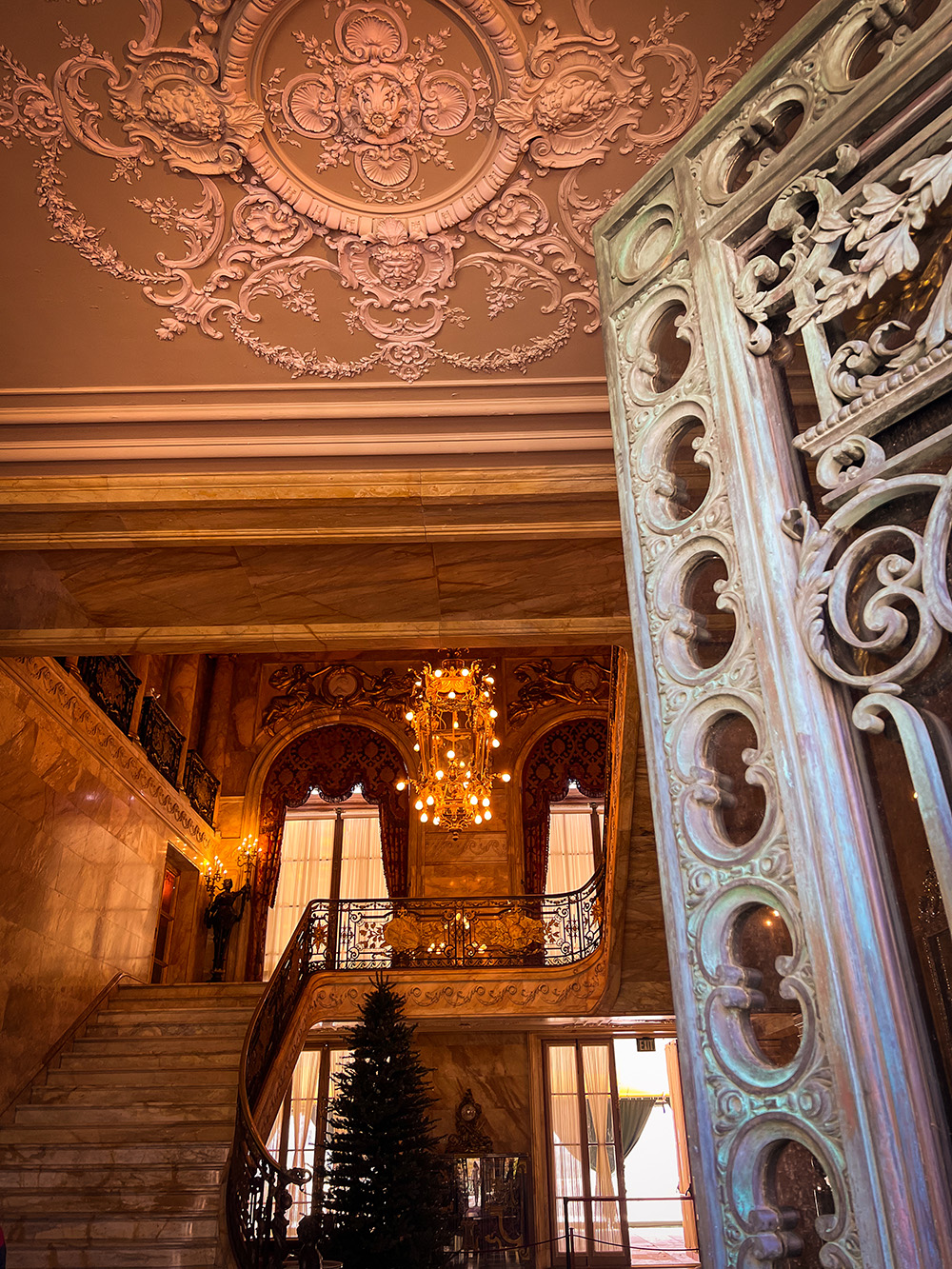
It was glorious. I immediately liked it better than the breakers. There was just something about the vibe that was different.

Our first stop beyond the entrance was the dining room.

The chairs are made of velvet and bronze, and weighed 100 pounds each. That sounds fancy, but in reality I think that would be extremely annoying. Imagine trying to sit down for dinner and you can’t even scoot your own chair in closer to the table? You would constantly need another grown adult to push you in, and I think that would be infantilizing in a way that would make me question why we had the damn chairs to begin with.
A recurring theme in these mansions is never forgetting to look up – so let’s take a peek at the ceiling.
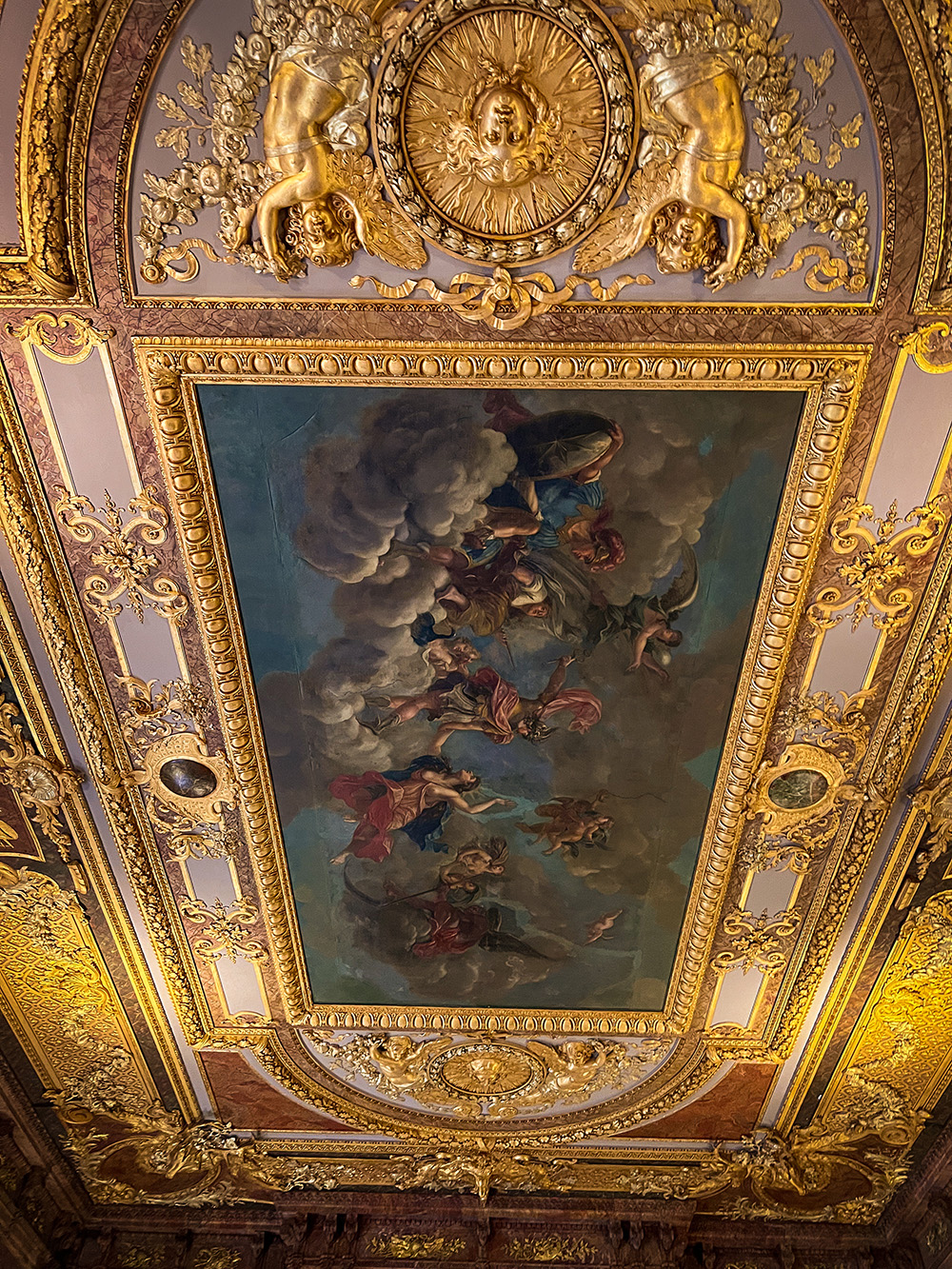
Another painting! How unexpected!
I noticed that there was some sun imagery in the gilded ceiling, which reminded me of Versailles – again, the location of inspiration for this home. Louis XIV was called the Sun King, so there was a lot of sun imagery at Versailles, as well. Not by coincidence, I’m sure, is the portrait of Louis XIV at the head of the dining room.
Our next stop was the library, which no surprise, I liked.
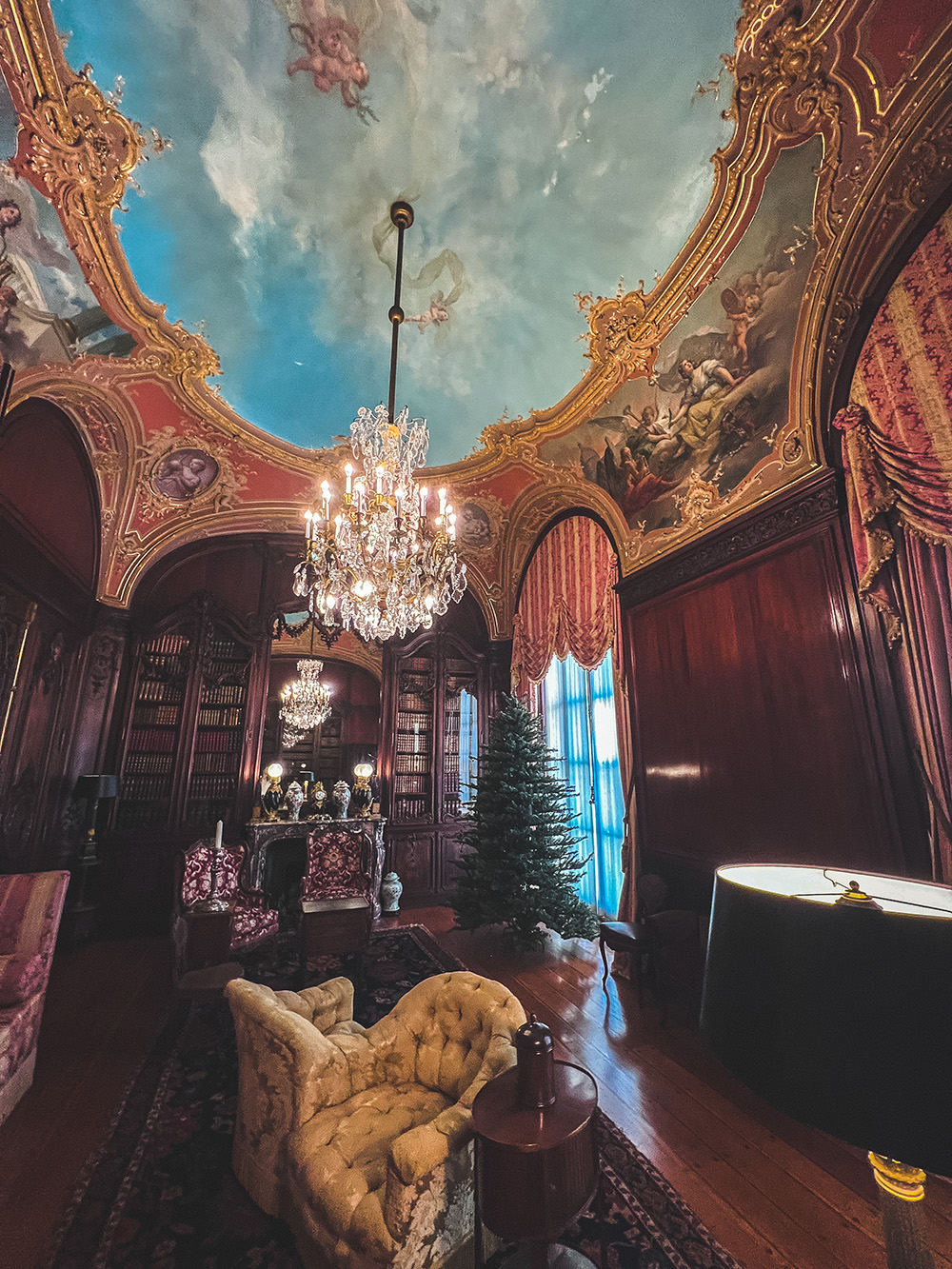
Could have had more books, in my opinion.
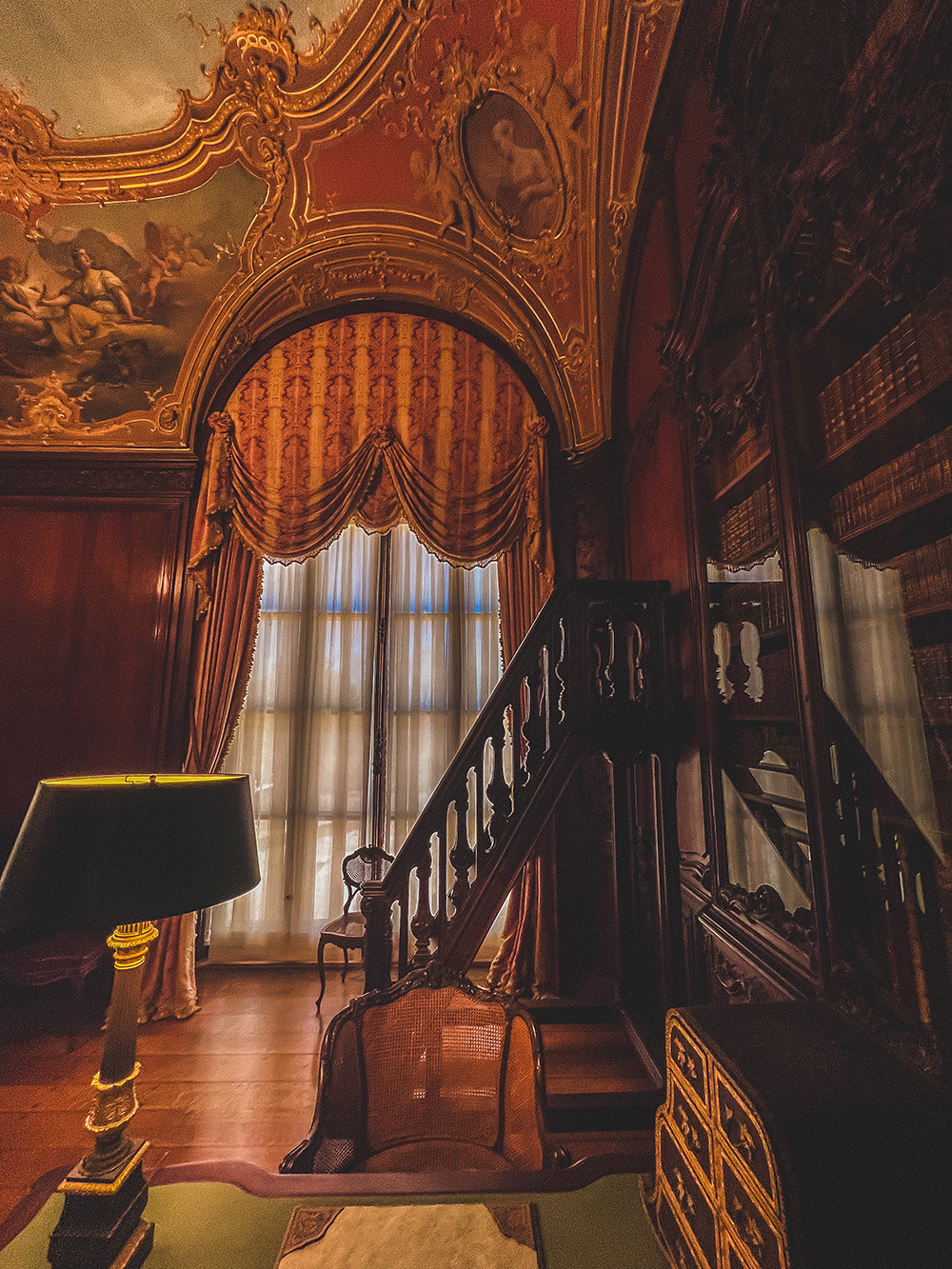
I imagine it was a nice place to cozy up and read, though.
And again, we have some cool ceilings.
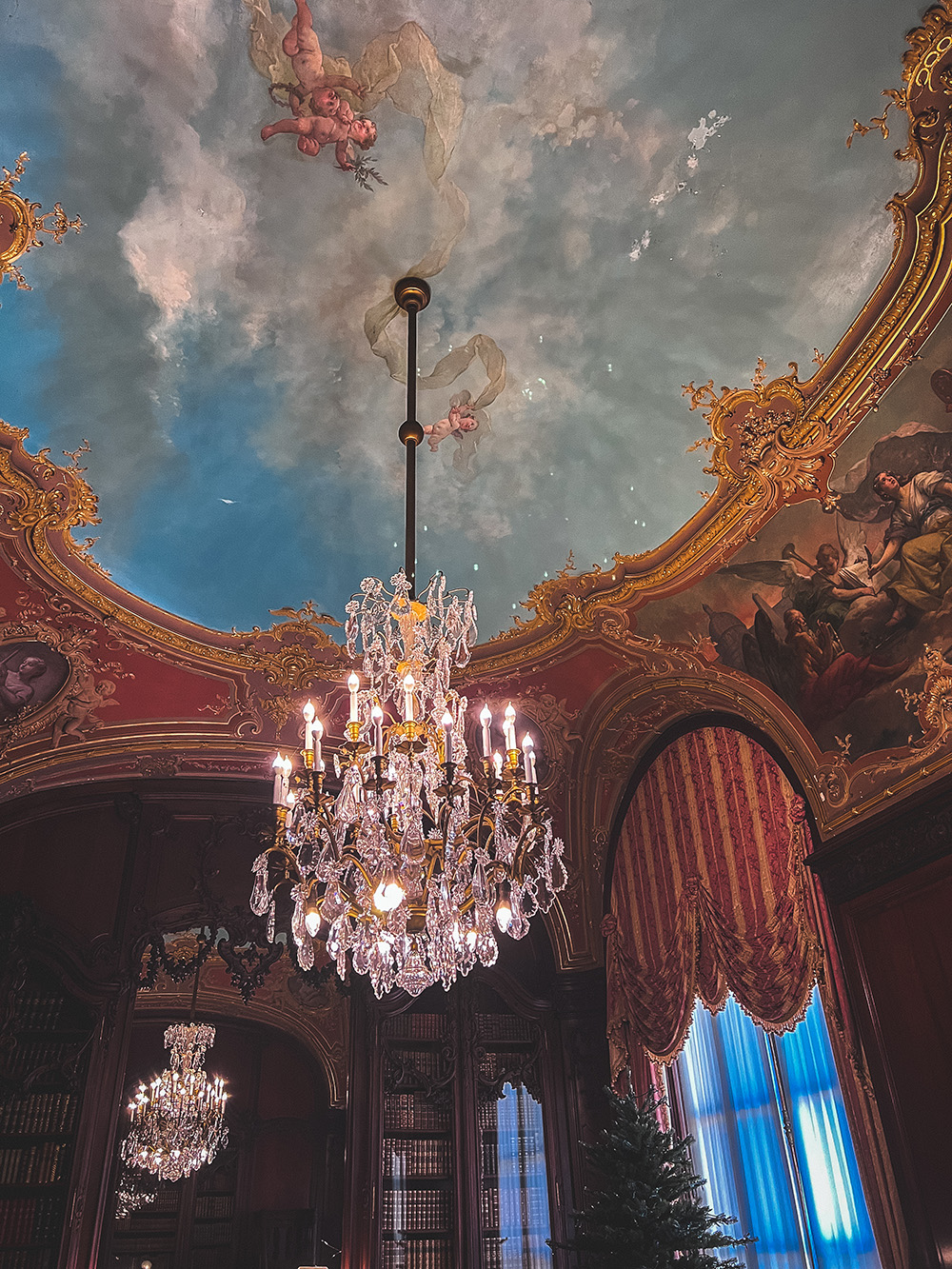
This one needed a little patching, which made me wonder how they go about retouching the ceilings when there are issues with the paint.
When you exit the library, there’s a door that takes you out to the patio, and the handles of the door again reminded me of the little details I noticed at Versailles. More Sun King imagery.
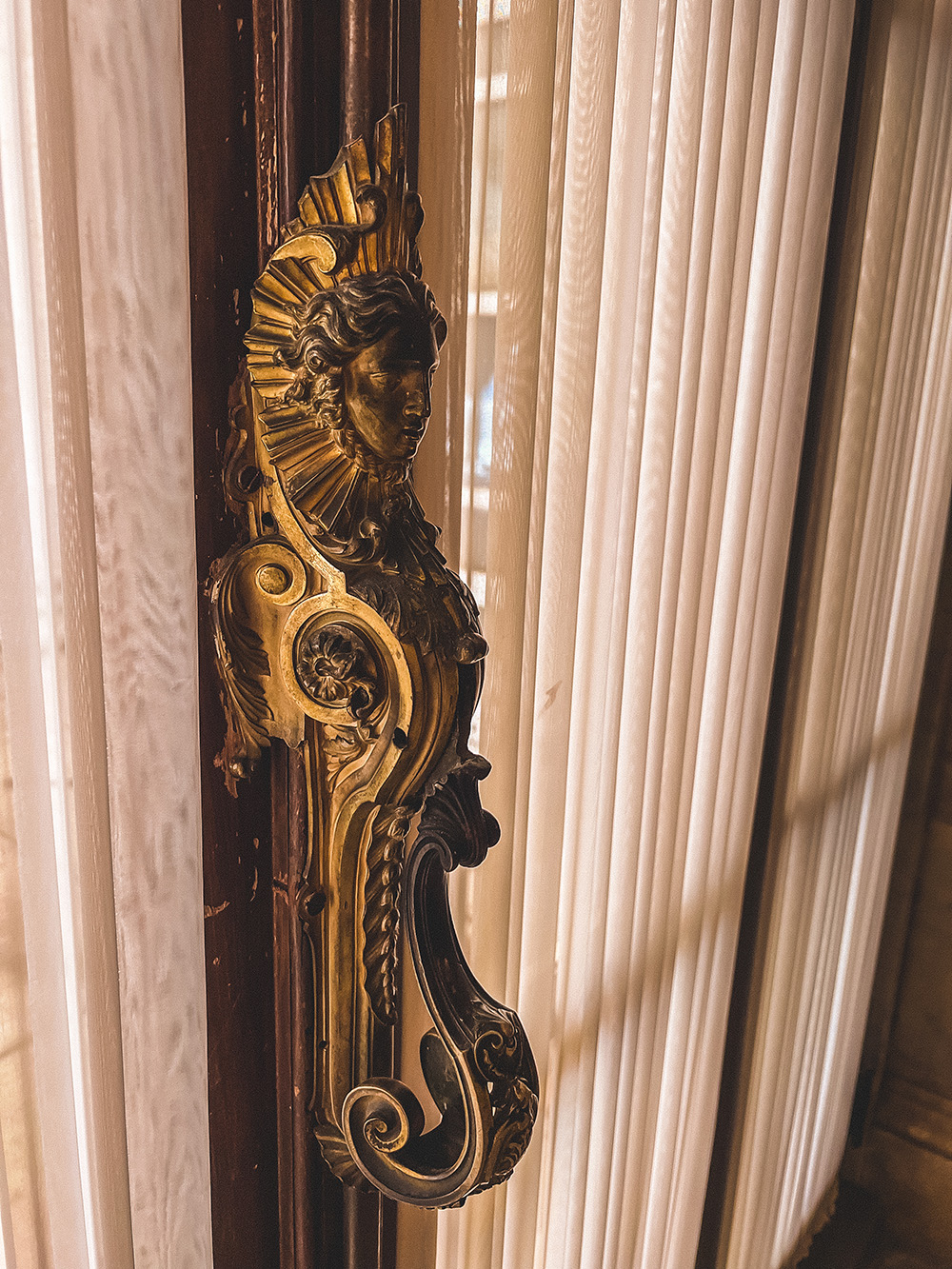
The next room, the Gothic Room, took a shift in tone – suddenly we’re in Strasbourg!
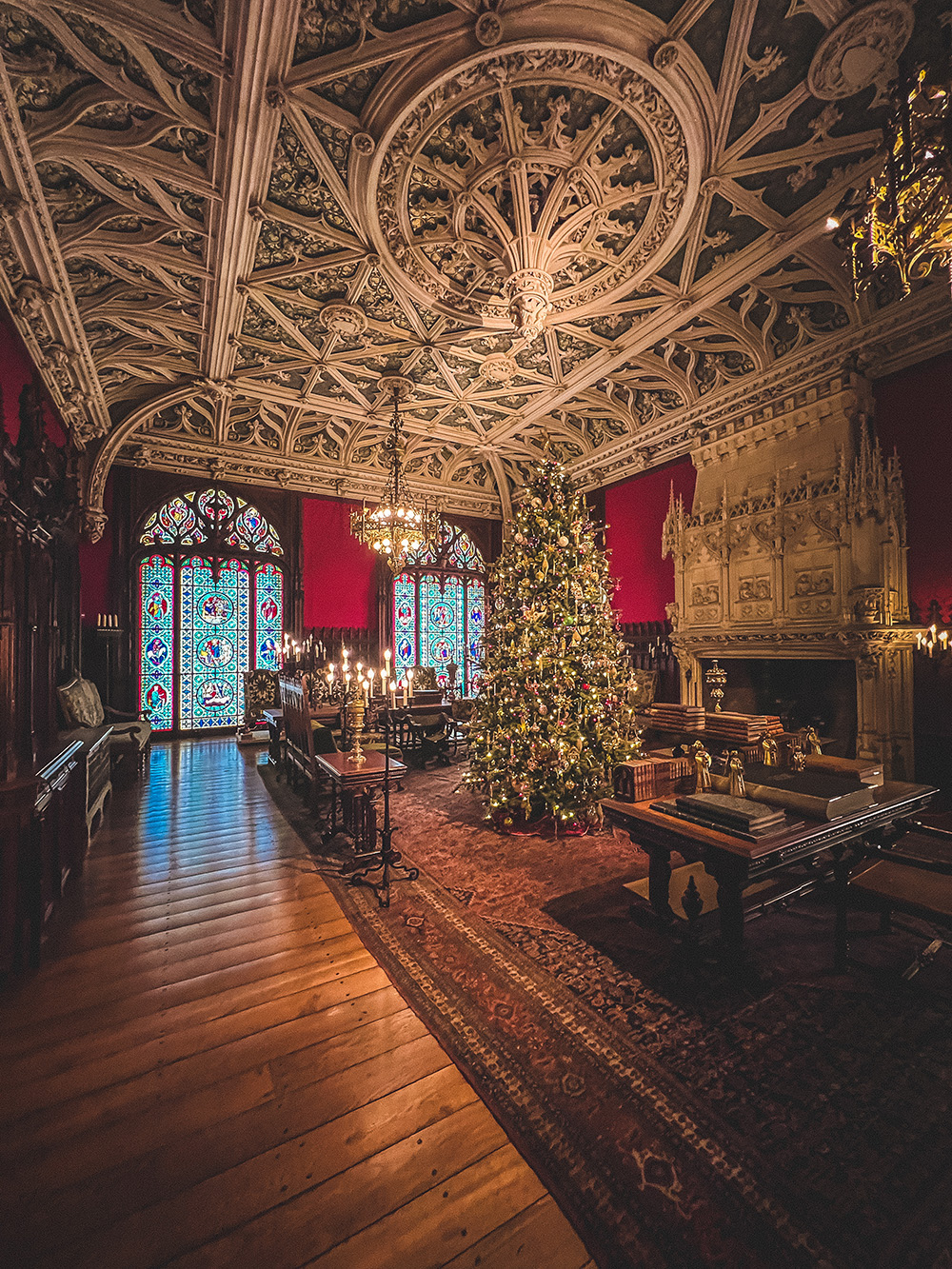
It truly felt like stepping into a European cathedral – especially with the stained glass.
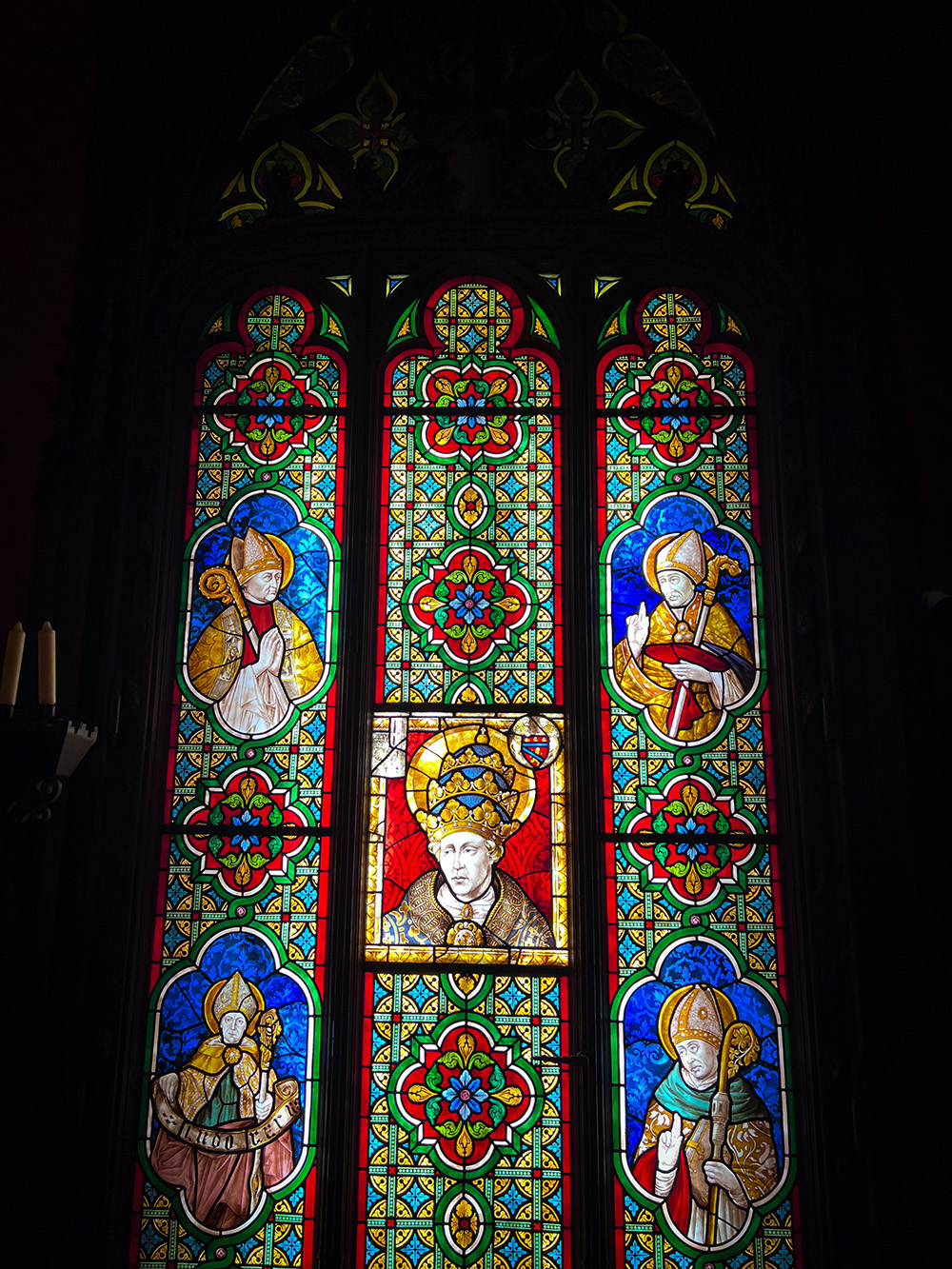
They’d begun setting up of Christmas, and the tree was beautiful.

I could see myself reading a book while snuggled up on one of those velvet chairs.
Through the Gothic Room was their ballroom, which was one of the most insane rooms in the house, mostly because the walls were literally gold.
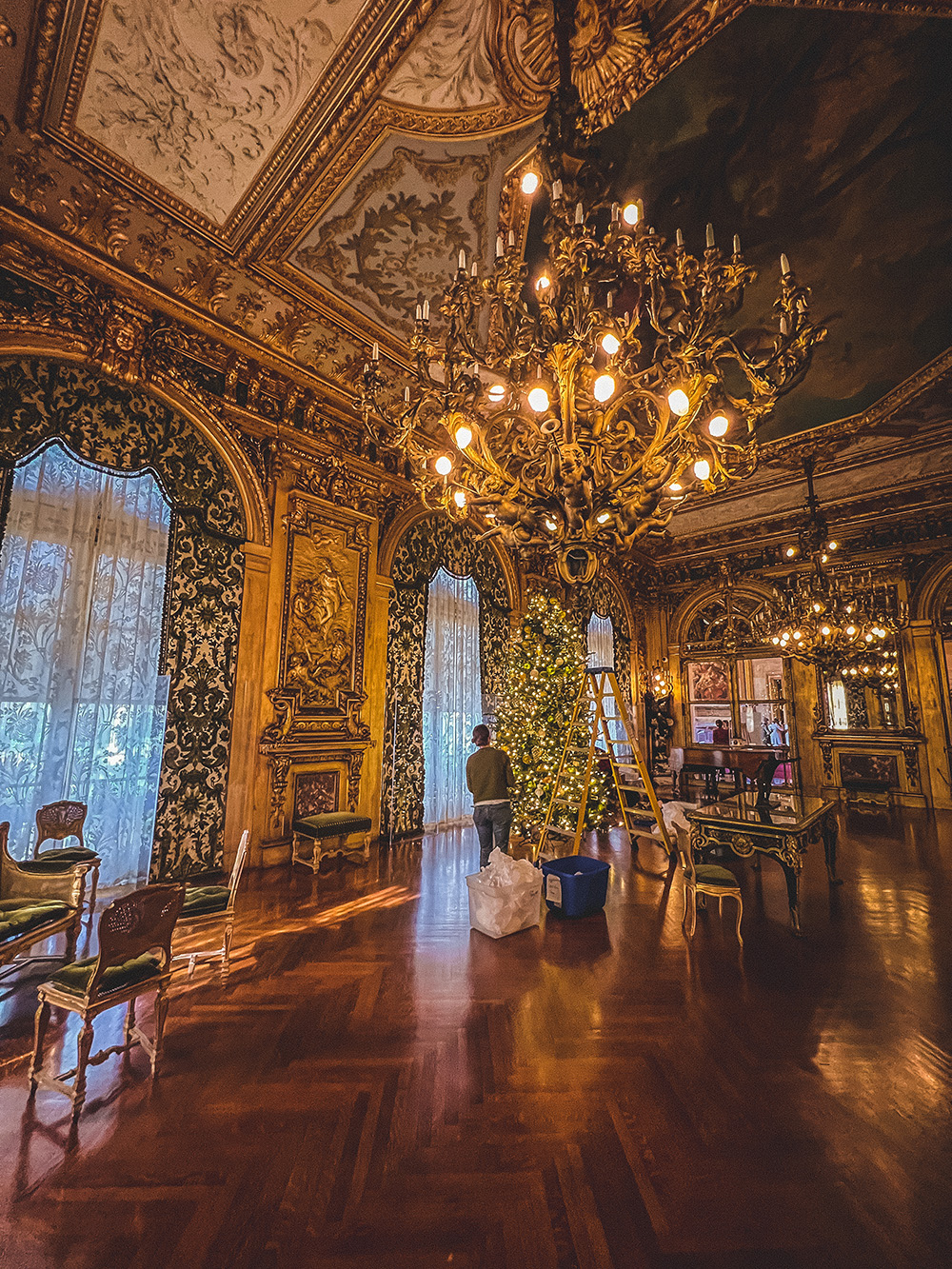
Yes, literal gold walls.
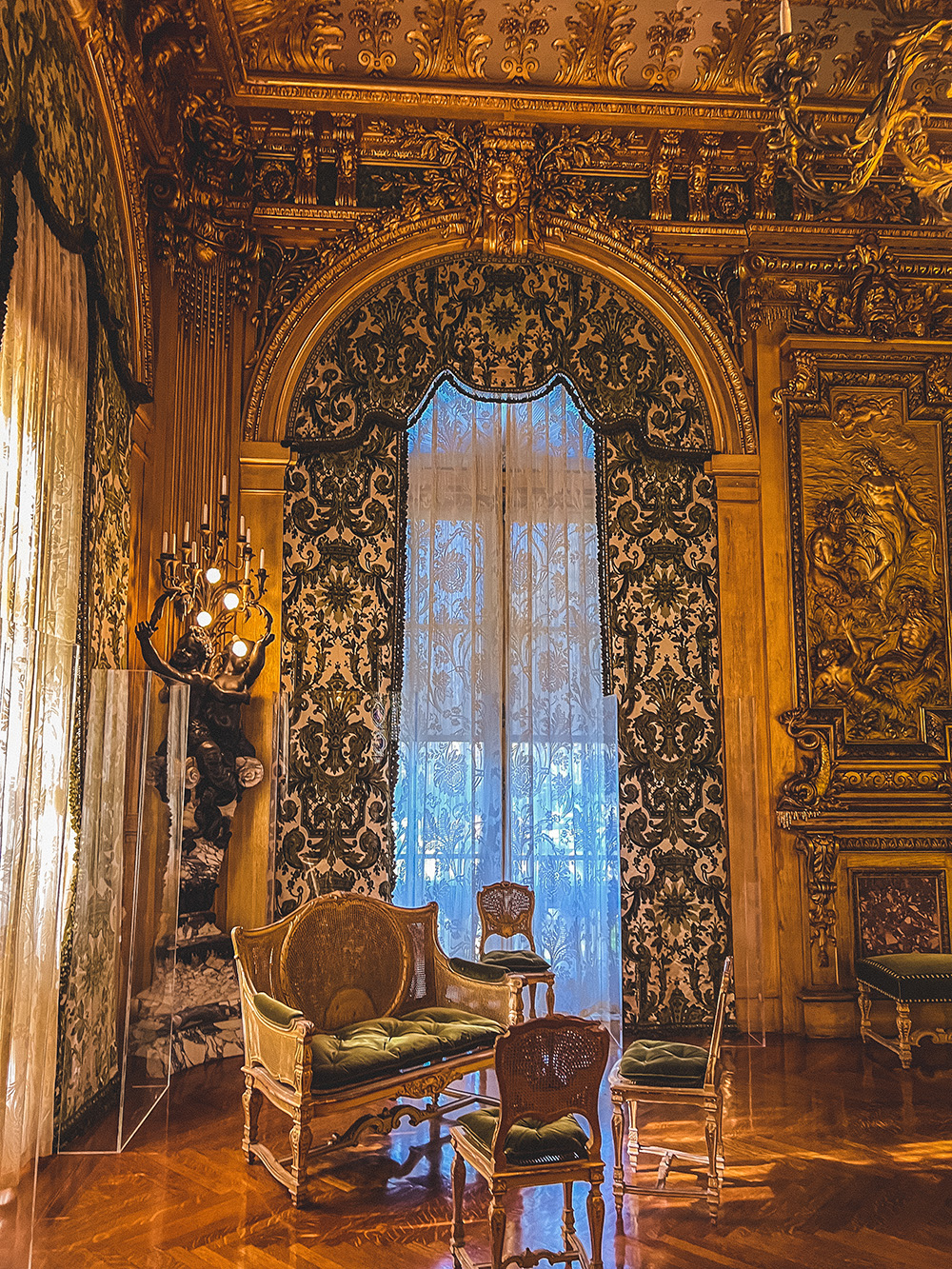
I loved the curtains in this room, and noticed they had little Apollos on them – it actually looked more like small medusas to me, which felt more in line with Alva Vanderbilt’s history as a badass woman.

And the fireplace – I can only imagine how these gold walls would look while a fire was illuminating the room from this fireplace.

We all know I’m a sucker for a chandelier, so let’s admire this gilded one.
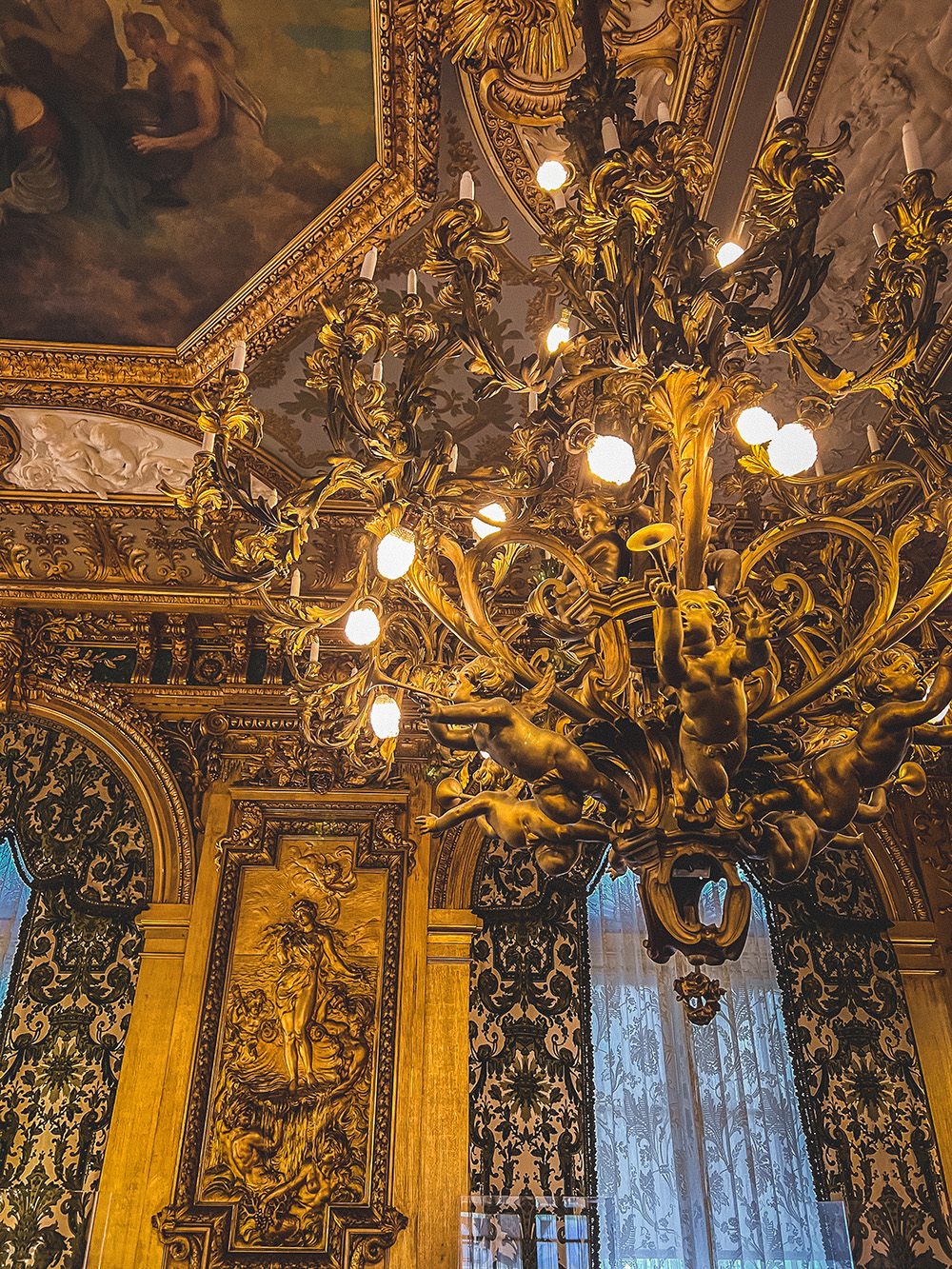
They really said, “We see your Hall of Mirrors, and we raise you gilded walls.”

I would have danced my heart out at a party in this room.
We couldn’t sit in this room forever, so reluctantly we left and headed upstairs.

More sun imagery, and my favorite ceiling yet.
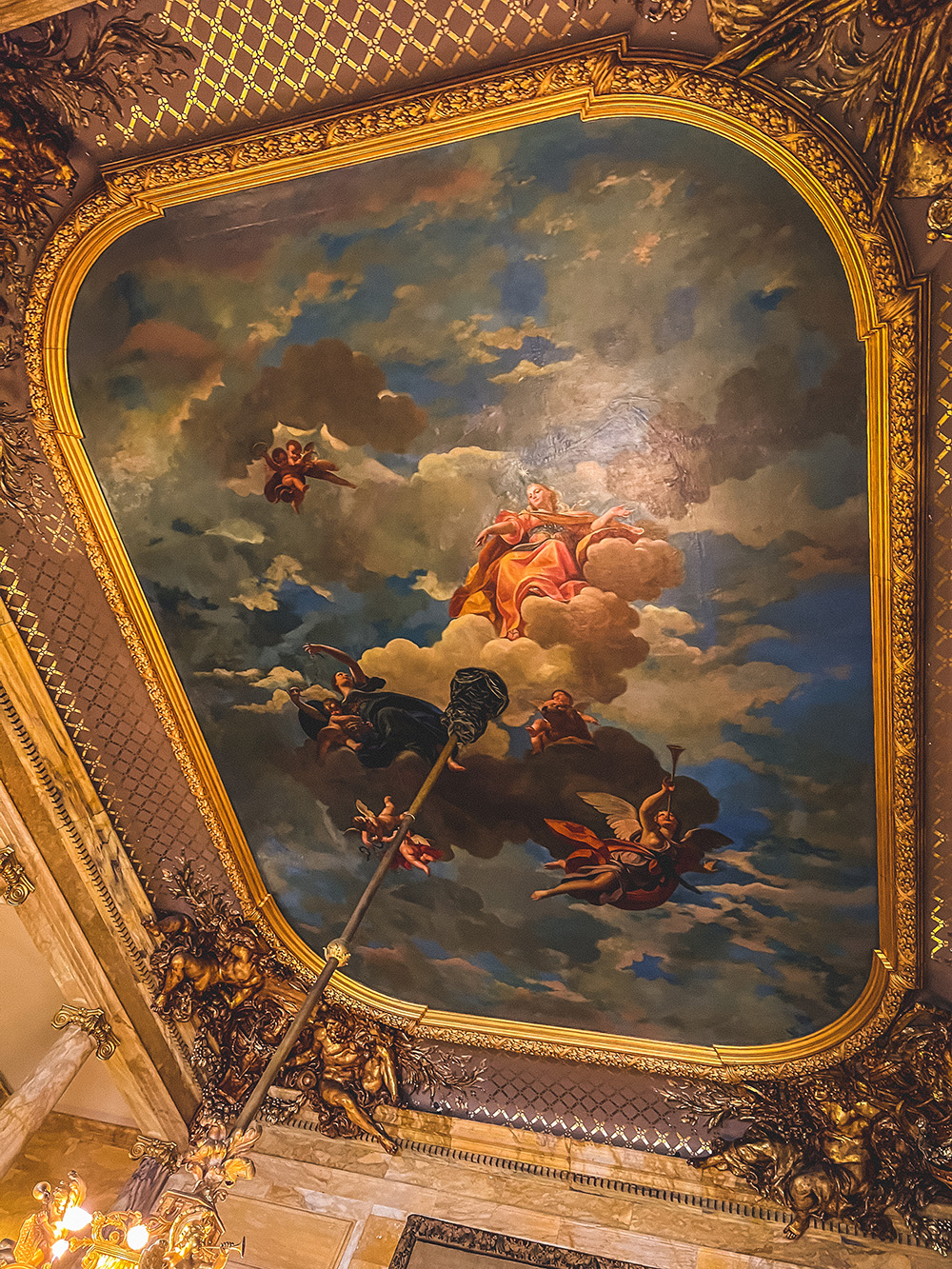
It really looks like she is looking down at you from the clouds.
The staircase to the additional floors was a gorgeous wooden spiral staircase in a very dark wood.
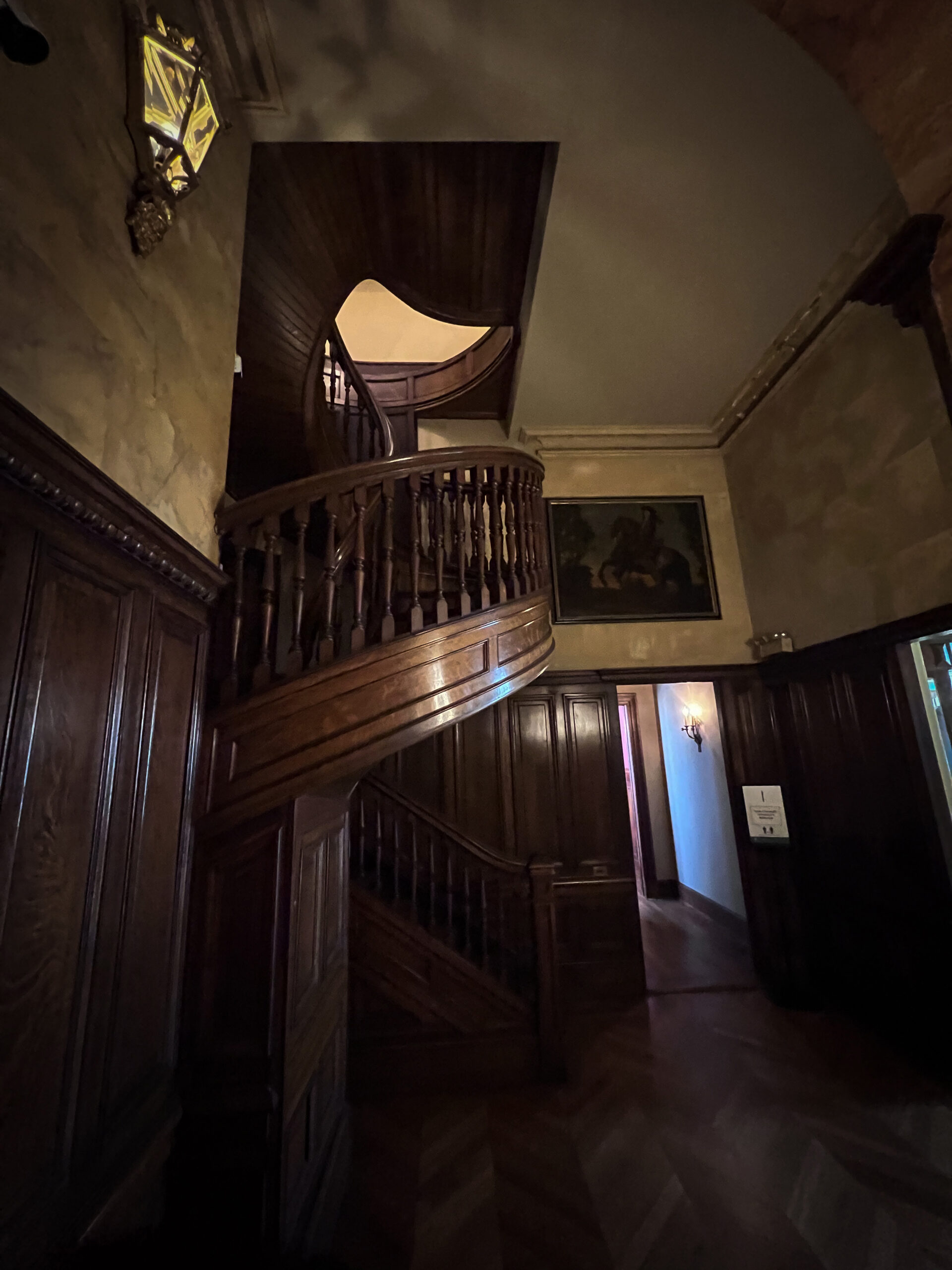
The tour was limited to this floor, so we weren’t able to climb the staircase, which was a bummer. They just look like they’d be fun to walk up.
Beyond the stairs was Consuelo Vanderbilt’s room.

Consuelo’s room was in rich reds and deep walnut colors, altogether it again reminded me more of Strasbourg or a German influence than the Versailles scheme of the majority of the mansion.
Consuelo was one of the great beauties of the Gilded Age, and had a bit of a tragic love story – she fell in love and became secretly engaged to a man named Winthrop Rutherford, but her mother, Alva, forced her to marry the Duke of Marlborough.
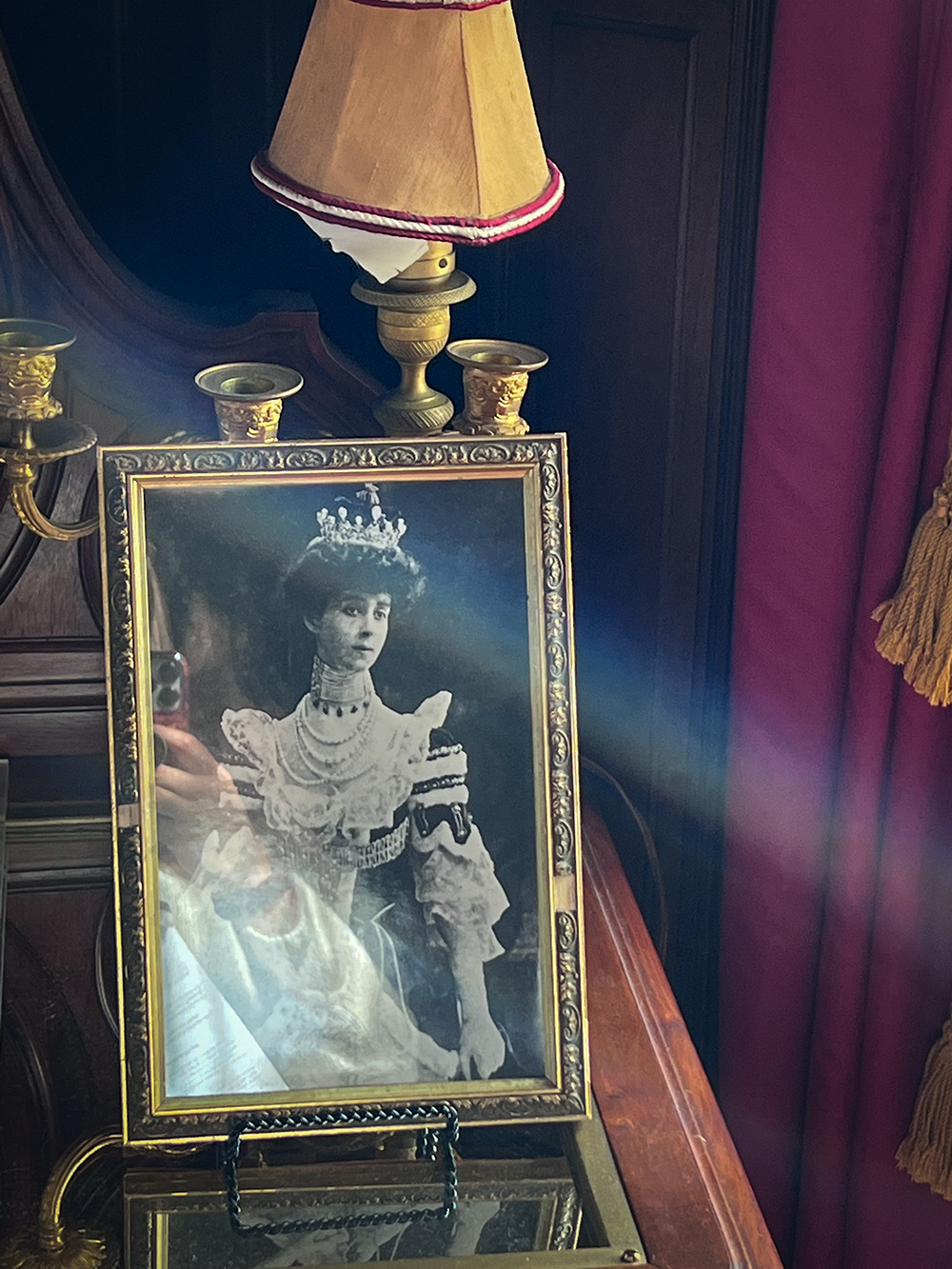
Alva was deeply involved in the women’s suffrage movement, so it strikes me as odd that she forced her daughter to marry for status over love, especially when Alva herself divorced her Vanderbilt husband after she discovered he was cheating on her. She kept the Marble House, since it had been gifted to her, and ended up remarrying.
Consuelo ended up marrying the Duke of Marlborough and eventually become good friends with the duke’s cousin, Winston Churchill. Consuelo was unsatisfied with the juxtaposition of her life of luxury and the hardships of the majority of the world, so she dedicated her life to social causes, also joining the fight for women’s suffrage in both the U.S. and the U.K.
Here she is speaking in London about her social work.
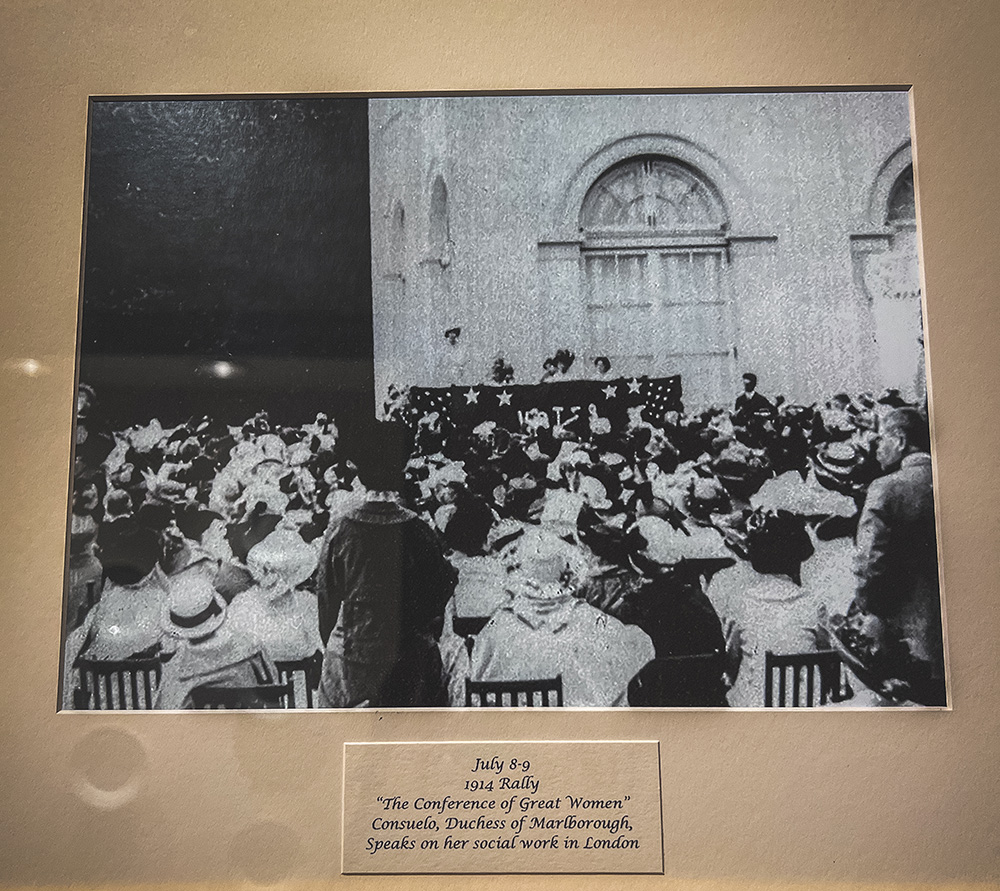
She also founded the Homes for Prisoner’s Wives and Children in London.
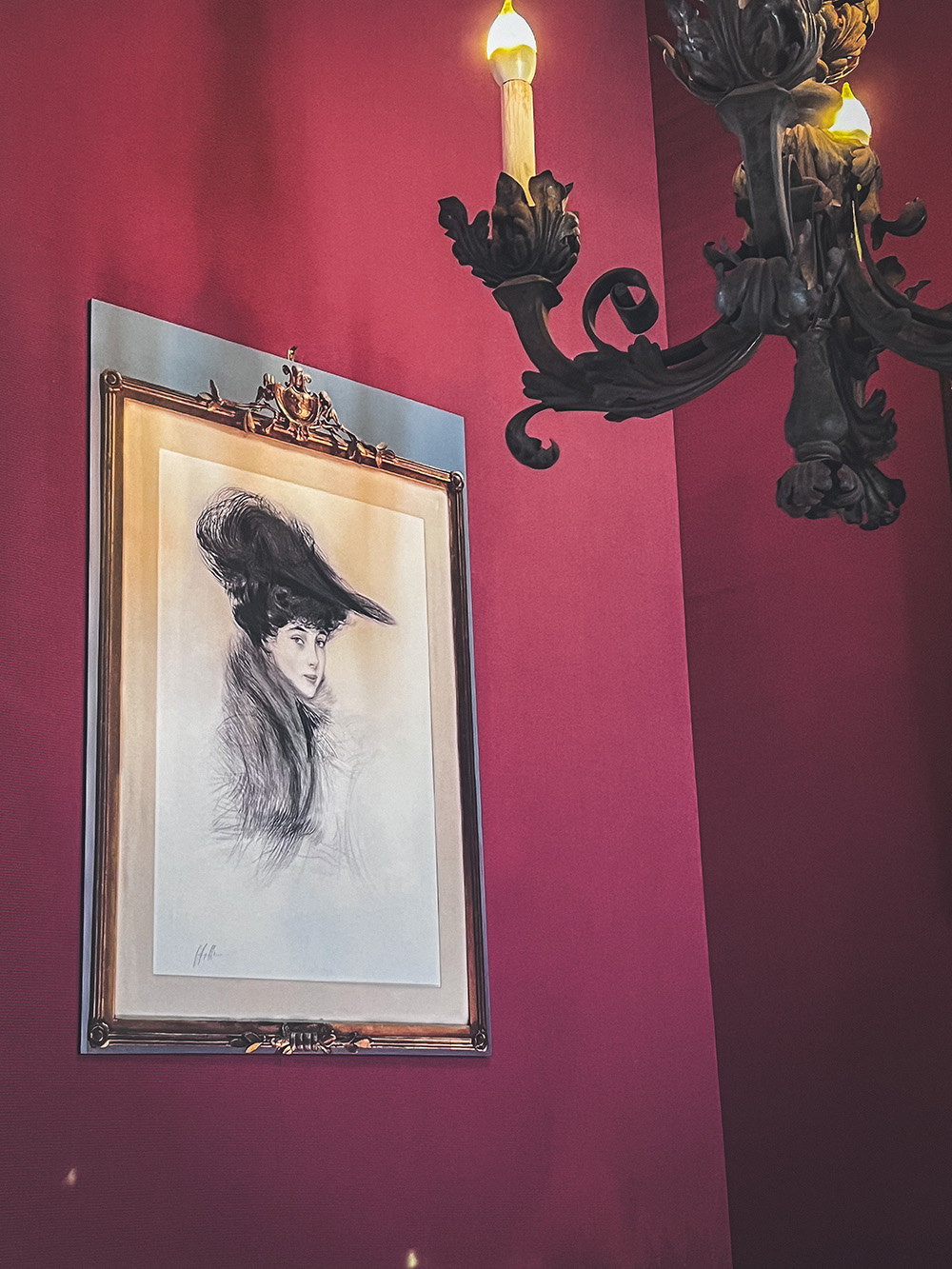
Luckily for her story’s end, Consuelo divorced the man she was forced to marry at age 43, and married a French aviator, Jacques Balsan. While living in France with him, she received the Legion of Honor for her work establishing hospitals, and eventually ended up on the Nazi hostage list during World War II because of her work. She escaped to the U.S. and lived between Long Island and Florida with Jacques.
While it frustrated me that Alva forced her daughter into a loveless marriage, there are other parts of Alva’s story that I admire. Let’s visit her room next – it was my favorite room in the house.

It had more soothing colors, and while it was just as extravagant as the rest of the house, it felt more calming.
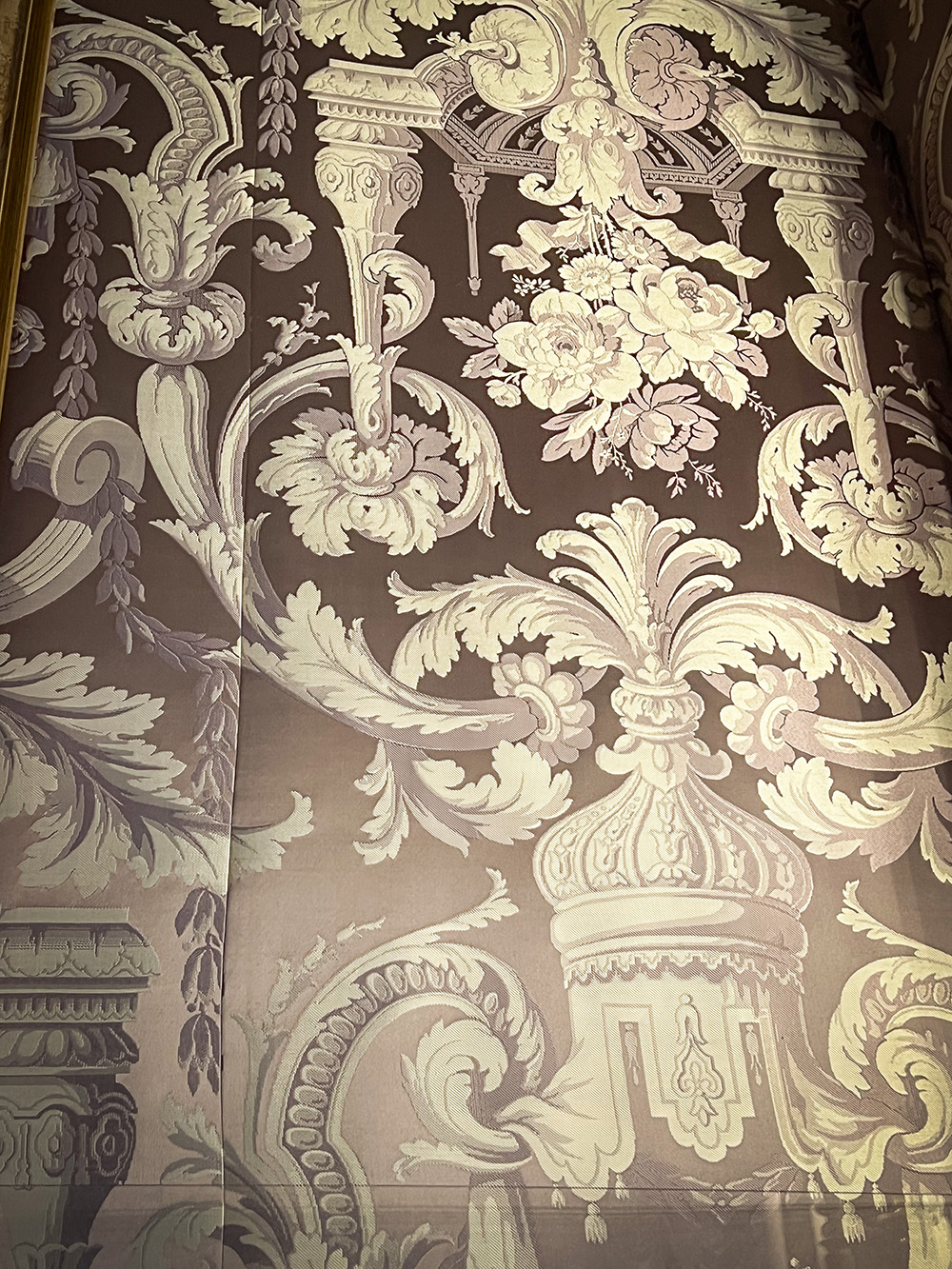
I loved the wallpaper.
Alva was described as a fiery woman, which we love to hear, especially for someone born in 1893.

She was born in Alabama but grew up in France, which is where her interest in French culture and design began. After marrying William Vanderbilt, the grandson of Cornelius, she worked with Richard Morris Hunt to build the Marble House as well as the Vanderbilt’s 5th Avenue home.
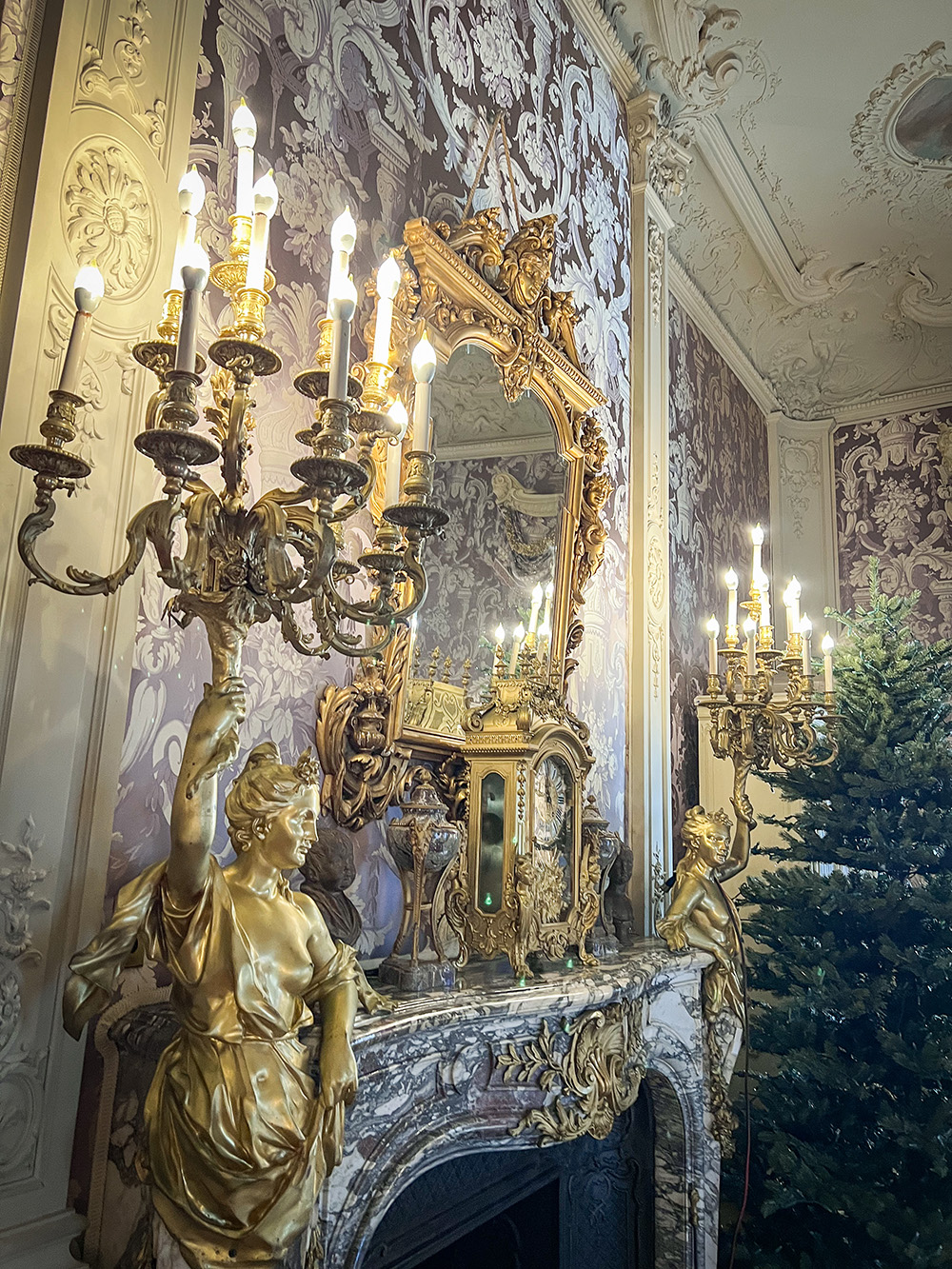
Alva was one of the first female members of the American Institute of Architects, earning her membership because of her work on both homes.

Athena, the goddess of wisdom and victory, looks down at you from the ceiling of Alva’s room.
After she divorced William Vanderbilt, she kept the house, custody of all three of her children, and $100,000 a year. She retained her social status and was unscathed by the divorce – virtually unheard of.
She dedicated the rest of her life and wealth to women’s rights. One of my favorite things at the Marble House was Alva’s china collection. She had “Votes for Women” printed on everything – plates, cups, tea kettles, gravy boats. All of it. If you were eating off her plates, you were going to be talking about women’s rights.

Alva also held rallies for women’s rights in the tea house at the back of the property.

You can normally have tea here, but it was closed when we visited.
Not only did she hold rallies here, but she also let the Congressional Union for Woman Suffrage use the Marble House as its headquarters.
Alva eventually returned to France, where she died at age 80. Here’s a quote from her that I absolutely love – imagine a woman saying this in the early 1900s. Chills.
“Henceforth women are to be dictators. The time has come to take this world muddle that men have created and strive to turn it into an ordered, peaceful, happy abiding place for humanity.”
She was a badass and you can’t convince me otherwise.
Ok, let’s see her cheating husband’s bedroom.

It’s fine, I guess.
Ok, ok, biases aside, the room is lovely.
They also had a beautiful guest room.

Invite me over, I’ll stay awhile.
The last stop on our tour was the kitchen, which was very similar to that at The Breakers.
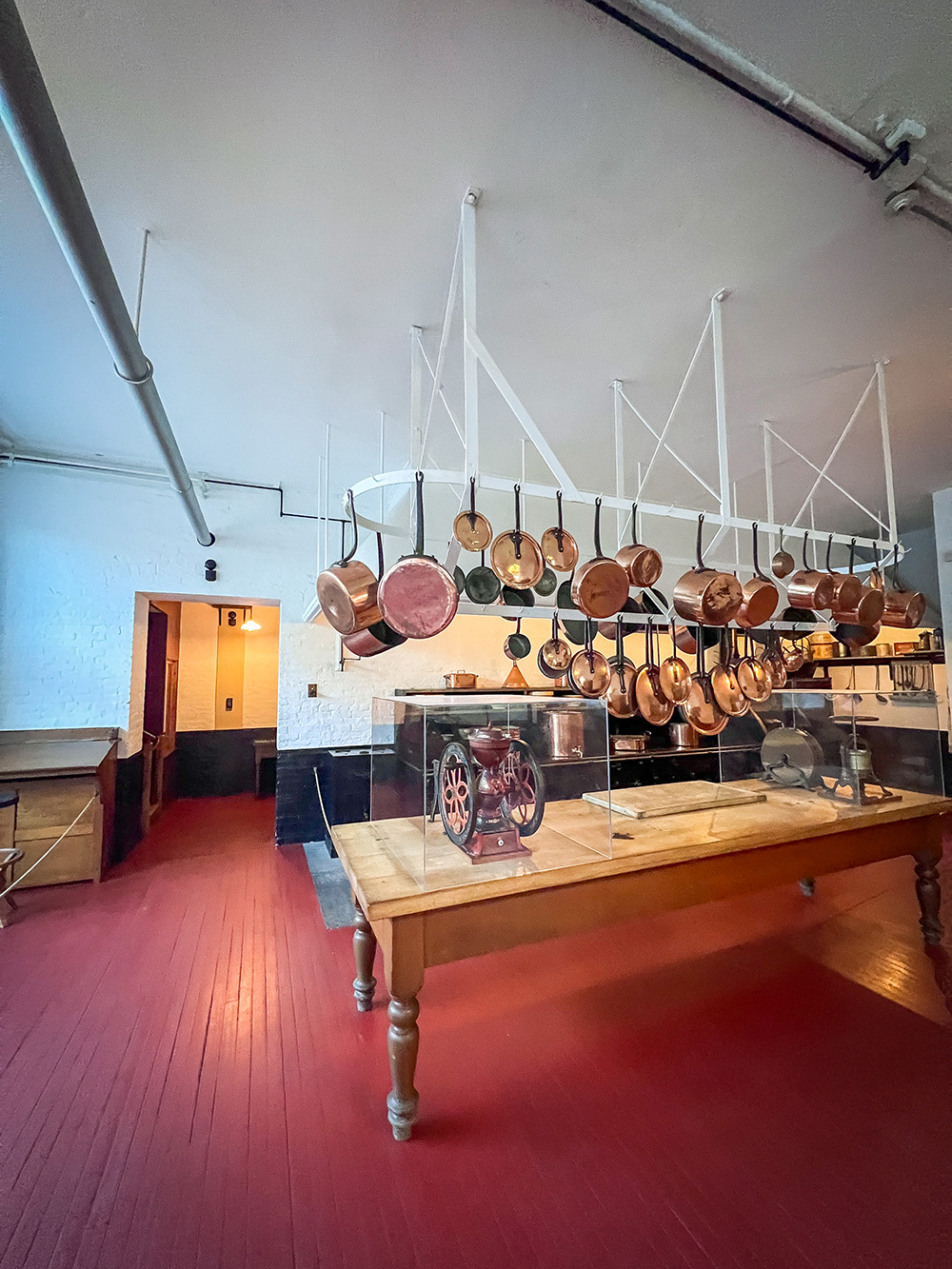
Apparently HBO’s “The Gilded Age” filmed here, which feels appropriate.
All in all, I liked the Marble House much more than The Breakers. It may sound odd to say this, given the 500,000 feet of marble and the gilded walls, but the Marble House felt much more like an actual home. It was smaller and more intimate, whereas The Breakers felt like a palace or museum. The Breakers had a coldness to it where the Marble House had warmth.
I think it also made a difference to me that while Consuelo and Alva clearly benefited from and enjoyed their wealth, they didn’t let it stop with them. They used their status to impact change and help others, and were extremely passionate about pushing women forward in society. It didn’t feel like their social status went to waste on them, even if the mansion was excessive in its splendor.
If I had to choose between touring The Breakers and the Marble House, I would definitely choose the Marble House. It’s worth seeing The Breakers for its insane level of wealth, but the Marble House had better history.
That afternoon, we’d head to Boston, where we’d spend the final days of our East Coast excursion.
There’s more adventure ahead!
Let’s Connect:
